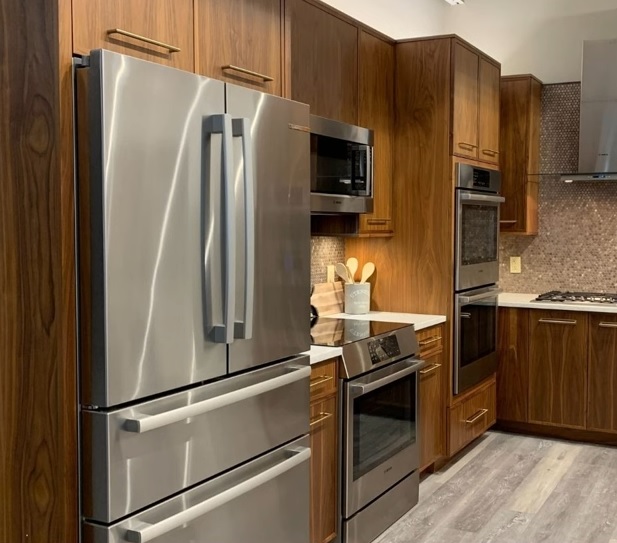A counter-depth refrigerator will look better in your kitchen, while a standard-depth refrigerator will be up to seven cubic feet bigger for $100 to $390 less than the identical counter-depth refrigerator.
In this article, you’ll learn the pros and cons of both styles so you can make an informed decision in your kitchen.
In the end, I will show you a hack on how to have the capacity of the standard-depth with the better looks of the counter-depth.
Capacity
A counter-depth is 19.8 to 24 cubic feet, with the standard-depth being 26 to 30 cubic feet in capacity.
Let’s look at the pros and cons of each, and then we’ll show you how to combine the benefits of both.
Counter Depth
Counter-depth looks better because the refrigerator is only 24 inches deep and only the door will protrude past your counters.
Your standard counter is 24 inches, so you won’t see the unattractive textured sides of the refrigerator protruding into your kitchen.
If your refrigerator is in the middle of your kitchen or in a smaller design, like in an apartment, counter depth will always look better.
In kitchens with islands, a counter-depth will give you better clearance between the refrigerator and the island, which is important with two or more people using the kitchen at the same time.
The cons associated with counter-depth refrigerators are their lower capacity and their higher price, which are the reasons to consider a standard-depth refrigerator.
Standard Depth
Standard-depth will give you another four to seven cubic feet, depending on the manufacturer. So if you have a larger family or store trays and platters, then the standard depth will serve you better.
You may think that you’ll pay more for a standard-depth, but actually you’ll end up paying less about $100 to $390 less in most popular styles.
For example, the LG InstaView 4 door with Craft Ice is $3,899 in a counter-depth and only $3,509 for the larger 28 cubic foot standard-depth.
Want the Profile with the Keuirg? It’s $3,799 in the 27 cubic ft. versus $3,999 in the identical 22.3 cubic ft. counter-depth.
The most reasonable difference in price was from Samsung. There’s only a $100 difference between their 29 cubic ft. standard refrigerator and their 23 cubic ft. counter depth 4 door flex units.
Price
So why the price difference?
Manufacturers years ago claimed to produce less counter-depths and had to charge more per unit.
Fast forward to today, with counter-depths being the more popularly bought unit. Maybe they just charge more because they can.
Bonus
So here’s how to have the capacity of a standard-depth and the looks of a counter-depth.
You see this a lot in luxury kitchens, where they’re trying to make everything seamless and integrated into the cabinets.
First, you want to build the cabinets or the refrigerator enclosure out to cover the sides of your standard-depth refrigerator, instead of just building them out 24 inches.
Standard refrigerator depth is roughly 29 inches but varies by manufacturers, so always double check the depth of the textured sides before choosing your refrigerator.
This trick will work better at the end of your kitchen or on the opposite wall of your stove, dishwasher and other appliances that are 24 inches deep.
The refrigerator doesn’t have to be centralized in any way, like your cooktop sink and dishwasher.
By building out the enclosure, you’re creating the aesthetic of a counter depth, while still benefiting from the larger capacity and lower price of a standard-depth refrigerator.
Key Takeaways
Counter-depth does look better in kitchens, especially with islands.
However, standard-depth will give you a lot more cubic feet, even as you somehow pay less.
Keep in mind, you can combine the benefits of both by taking a larger standard-depth refrigerator and building out your cabinets to cover the unattractive sides to give the illusion of a counter-depth refrigerator.

